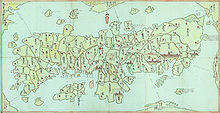| Miike Domain 三池藩 | |
|---|---|
| Domain of Japan | |
| 1621–1871 | |
| Capital | Miike jin'ya |
| • Type | Daimyō |
| Historical era | Edo period |
• Established | 1621 |
• Disestablished | 1871 |
| Today part of | Fukuoka Prefecture |
Miike Domain (三池藩, Miike-han) was a Japanese domain of the Edo period. It was associated with Chikugo Province in modern-day Fukuoka Prefecture on the island of Kyushu.
In the han system, Miike was a political and economic abstraction based on periodic cadastral surveys and projected agricultural yields.[1] In other words, the domain was defined in terms of kokudaka, not land area.[2] This was different from the feudalism of the West.
List of daimyōs
The hereditary daimyōs were head of the clan and head of the domain.
![]() Tachibana clan, 1621–1806; 1868–1871 (tozama; 10,000 koku)
Tachibana clan, 1621–1806; 1868–1871 (tozama; 10,000 koku)
- Tanetsugu
- Tanenaga
- Taneakira
- Tsuranaga
- Nagahiro
- Tanechika
- Taneyoshi (transfer to Shimotedo Domain, succeeded by Tachibana Taneharu)
- Taneyuki (returned from Shimotedo)
See also
References

Map of Japan, 1789 – the Han system affected cartography
- ^ Mass, Jeffrey P. and William B. Hauser. (1987). The Bakufu in Japanese History, p. 150.
- ^ Elison, George and Bardwell L. Smith (1987). Warlords, Artists, & Commoners: Japan in the Sixteenth Century, p. 18.
External links
- "Miike" at Edo 300 (in Japanese)